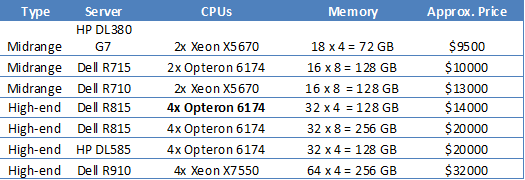Server Clash: DELL's Quad Opteron DELL R815 vs HP's DL380 G7 and SGI's Altix UV10
by Johan De Gelas on September 9, 2010 7:30 AM EST- Posted in
- IT Computing
- AMD
- Intel
- Xeon
- Opteron
The Quad Opteron Alternative
Servers with the newest Intel six-core Xeon hit the market in April. The fastest six-cores Xeons were able to offer up to twice the performance of six-core Opteron “Istanbul”. The reason for this was that the age of the integer core in AMD's Opteron was starting to show. While the floating point part got a significant overhaul in 2007 with the AMD "Barcelona" quad-core chip, the integer part was a tuned version of the K8, launched back in 2003. This was partly compensated by large improvements in the multi-core performance scaling departement: HT-assist, faster CPU interconnects, larger L3 caches, and so on.
To counter this lower per-core performance, AMD's efforts focused on the "Magny-Cours" MCMs that scaled even better thanks to HT 3.0 and four DDR3 memory controllers. AMD’s twelve-core processors were launched at the end of March 2010, but servers based on these “Magny-Cours” Opterons were hard to find. So for a few months, Intel dominated the midrange and high-end server market. HP and Dell informed us that they would launch the "Magny-Cours" servers in June 2010. That is history now, and server buyers have an alternative again for the ubiquitous Xeon Servers.
AMD’s strategy to make their newest platform attractive is pretty simple: be very generous with cores. For example, you get 12 Opteron cores at 2.1GHz for the price of a six-core Xeon 2.66GHz (See our overview of SKUs). In our previous article, we measured that on average, a dual socket twelve-core Opteron is competitive with a similar Xeon server. It is a pretty muddy picture though: the Opteron wins in some applications, the Xeon wins in others. The extra DDR3 memory channel and the resulting higher bandwidth makes the Opteron the choice for most HPC applications. The Opteron has a small advantage in OLAP databases and the virtualization benchmarks are a neck and neck race. The Xeon wins in applications like rendering, OLTP and ERP, although again with a small margin.
But if the AMD platform really wants to lure away significant numbers of customers, AMD will have to do better than being slightly faster or slightly slower. There are many more Xeon based servers out there, so AMD Opteron based servers have to rise above the crowd. And they did: the “core generosity” didn’t end with offering more cores per socket. All 6100 Opterons are quad socket capable: the price per core stays the same whether you want 12, 24 or 48 cores in your machine. AMD says they have “shattered the 4P tax, making 2P and 4P processors the same price.”
So dual socket Opterons servers are ok, offering competitive performance at a slightly lower price, most of the time. Nice, but not a head turner. The really interesting servers of the AMD platforms should be the quad socket ones. For a small price premium you get twice as many DIMM slots and processors as a dual socket Xeon server. That means that a quad socket Opteron 6100 positions itself as a high-end alternative for a Dual Xeon 5600 server. If we take a quick look at the actual pricing of the large OEMs, the picture becomes very clear.

Compared to the DL380 G7 (72GB) speced above, the Dell R815 offers twice the amount of RAM while offering—theoretically—twice as much performance. The extra DIMM slots pay off: if you want 128GB, the dual Xeon servers have to use the more expensive 8GB DIMMs.










51 Comments
View All Comments
Chrisrodinis - Thursday, February 27, 2014 - link
This article is about Dell servers in 2010. For comparison purposes here is an overview of a Dell PowerEdge M420 Blade server. This video has cool effects with upbeat production values. Please check it out, thanks: https://www.youtube.com/watch?v=iKIG430z0PI